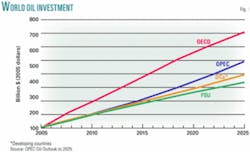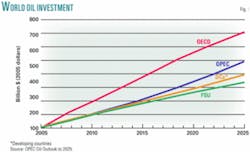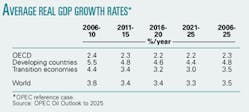The world’s leading oil producers seek an accurate forecast of energy demand as they plan for the nearly $2 trillion they’ll need to invest through 2025 to ensure energy supplies.
But the wide range of forecasts creates uncertainty, which raises investment risk, points out an outlook paper by the Organization of Petroleum Exporting Countries secretariat. Security of demand is therefore as important to producers as security of supply is to consumers.
What’s certain, says the paper, “OPEC Oil Outlook to 2025” delivered at the International Energy Forum in Doha at the end of April, is adequacy of the petroleum resource.
“The idea that oil production is soon to peak needs to be dispelled,” the paper said, calling it “a misconception.” The OPEC secretariat expects oil to remain the world’s leading world energy source through 2025.
The paper outlines a reference scenario in which oil demand rises by 30 million b/d in 20 years, reaching 113 million b/d by 2025 and representing average growth of 1.5 million b/d/year.
The International Energy Agency in Paris estimates current consumption at 85 million b/d.
Upstream investments
Supplying a market that grows at the projected rate requires upstream investment in the next 20 years totaling $1.9 trillion (2005 dollars), the OPEC paper says.
Of that, 37% will be spent in countries belonging to the Organization for Economic Cooperation and Development (OECD), where oil production decline rates and the costs of adding production capacity are the world’s highest.
Elsewhere, upstream spending needs will be about equal in OPEC, non-OPEC developing countries, and Russia and the Caspian region, with each of those groups requiring about $100 billion through 2010 and a further $100 billion each in 2010-15. Those estimates are for field development but exclude pipelines, storage, and port expenses.
After 2015, OPEC’s investments will outpace those of the former Soviet Union and developing countries (Fig. 1).
“The global scale of upstream investment this reference case outlook implies, however, is not expected to be greater in magnitude to that witnessed in the past,” the paper says. “This is the result of the gradual shift from higher- cost non-OPEC to lower-cost OPEC supply.”
Expansion of non-OPEC production capacity, the paper estimates, is “two or three times more costly than in OPEC, with this gap widening over time as average costs in non-OPEC regions gradually rise.”
OPEC plans to expand crude oil production capacity to nearly 38 million b/d by yearend 2010, up nearly 5 million from 2005. OPEC production capacity of NGLs and other liquids is expected to expand by nearly 2 million b/d to 6 million b/d by 2010. The paper cites more than 100 OPEC projects to expand production capacity, worth more than $100 billion.
It also links market uncertainty to the risks attached to OPEC members’ long-term investments.
“Uncertainty over future demand translates into large uncertainties over the amount of oil that OPEC member countries will eventually need to supply, signifying a heavy burden of risk,” it says. “Investment requirements are very large and subject to considerably long lead times and payback periods.”
On the basis of differences in demand projections based on differences in underlying assumptions, the paper calculates investment uncertainty at $50 billion in 2010, increasing to $140 billion by 2015 and $240 billion by 2020 (Fig. 2). “With more transparency in the evolution and implementation of policies, better assessments can be made as to how future demand is likely to evolve,” the paper says. “In turn, this would help make the appropriate capacity expansion decisions...while at the same time not wasting precious financial resources.”
OPEC members face competing needs for available financial resources. Education, health care, and infrastructure contend with energy for financing.
Uncertainties over possible future demand patterns probably are skewed toward reduced demand, the paper says, citing stringent energy and environmental policies in consuming countries and the likelihood of future technological developments.
Large levels of unused capacity could result in lower oil prices and huge revenues losses for producers.
Outlook uncertainty
In the lower-growth scenario of its uncertainty assessment, the paper projects world oil demand 10.5 million b/d lower than the reference case’s 113 million b/d by 2025.
The lower-growth scenario envisions the world economy expanding more slowly than in the reference case for various reasons, including a deadlock in the Doha round of the World Trade Organization discussions and problems for the US economy such as deflation. That scenario also reflects efforts to reduce oil demand growth through improved vehicle efficiencies in both developing and developed countries.
“Besides technological improvements in the efficiency of conventional internal combustion engines, the introduction of alternative vehicles could reduce the potential increase in oil demand for transport in the longer term,” OPEC said.
The higher-growth scenario calls for world oil demand 5.9 million b/d above the reference case forecast by 2025. Most of this additional growth is expected to come from developing countries. Average demand growth is estimated at 1.8 million b/d/year.
The high-demand scenario assumes that higher prices would be needed to support the necessary investments and that these prices would help support non-OPEC supply. Projected demand for OPEC oil, including NGLs and unconventional oil, is around 4 million b/d higher than the reference case.
Uncertainties concerning demand exist in both directions, the outlook paper says. “Stronger economic growth could emerge if geopolitical and economic conditions give an even stronger impetus to world trade and to capital flows and transfer of technology.”
Reference case
The OPEC paper’s reference case projects average growth in global gross domestic product through 2025 comparable to rates of 1995-2000, about 3.5%/year (see table).
Developing countries are expected to generate 80% of increased world oil demand, but countries belonging to the OECD will continue to account for the biggest share of the global total.
During the forecast period, the world’s population is expected to surge by 1.4 billion to nearly 8 billion, with 90% of the growth in developing countries.
Asian countries are expected to dominate oil demand increases. Through 2025, Asia will account for a rise of 17 million b/d, representing two thirds of the increase in all developing nations, the OPEC paper says.
Large differences in per-capita oil consumption will remain. In 2025, residents of developing countries will consume on average five times less oil than residents of OECD countries.
Transportation will drive oil demand growth. Secondary demand drivers will be residential and industrial sectors of developing countries, especially poor Asian and African countries.
Next week: Can refining capacity keep up?




